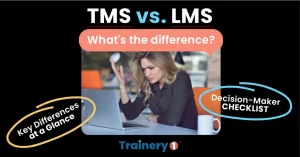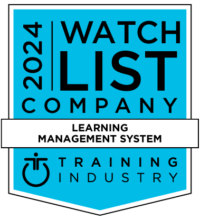On-demand workforce training and learning and development (L&D) platforms have been critical to advancing a rapid eLearning transformation as the country adapts to co-existence with COVID-19 restrictions. Cloud-based training solutions offer a wide range of comprehensive features, allowing organizations to easily deliver critical safety and compliance training to remote and distributed workforces.
Unfortunately, many small businesses assume these platforms are out of their reach due to budget, resource and time constraints. Instead, they rely on manual processes that may seem cheaper, but very often cost more in total time invested. Studies show that nearly 90% of spreadsheets contain errors, so companies that rely on these programs for tracking may be at a greater risk, and subsequently, noncompliance penalties due to errors and omissions in record-keeping.
The reality is even the smallest organization can—and should—take advantage of comprehensive, affordable eLearning technologies that can keep the organization up-to-date and moving forward.
Why Real-Time Training Tech is Critical
Even before the pandemic, eLearning and LMS (Learning Management System) technologies played a pivotal role in training and development, providing ease of access and on-demand learning for an increasingly distributed workforce. eLearning is the future of L&D and workforce training, largely because digital solutions offer far too many undeniable benefits.
Benefits include:
- A better Learner experience with on-demand access and self-paced modules that enable employees to train at a time and place that works best for their needs.
- Higher engagement and knowledge retention rates, enabling training concepts “to stick” and be put into practice more quickly and effectively.
- Ease of administration and participation, which saves time and expense. In fact, one study found that adopting mobile online learning platforms generates over 70% cost savings by reducing the time required to create new features and increased learner adoption.
- More timely training material through the convenience of off-the-shelf content libraries with situation-relevant content updates to reflect new guidance and mandates. This allows businesses to keep current with ongoing regulatory changes, giving them a competitive edge.
- Comprehensive, real-time tracking and reporting for verifiable, auditable records management and certification. With on-demand access to records and automated reminders for refresher training so that no one slips through the cracks, eLearning platforms make it easy to maintain and prove compliance in the event of an accident or audit.
- Flexibility to support a broad range of learning applications, including: HR policies & procedures, professional development, safety training, sector- and skill-specific needs, and federal regulatory requirements including OSHA, DOT, and DOL regulations, and COVID training, now required by 16 states.
- Blended learning flexibility. While some types of training are still better delivered face-to-face (medical procedures, heavy equipment training, etc.), integrating instructor-led training with cloud-based tools to digitize paper processes for sign-in, attendance and certification management can be more effective, more efficient and improve tracking and reporting accuracy.
Aside from these training-specific benefits, data also shows that digitizing is just good business practice. Small businesses that adopt digital solutions earn 2X more revenue per employee, drive 4X higher year-over-year revenue growth, and become 3X as likely to create new jobs than their non-digitized competitors.
How Small Business Can Get on Board
Implementing real-time eLearning can give small businesses a strong advantage in today’s fast-paced environment.
Fortunately, a wide variety of cloud-based learning solutions now offer flexible options, ranging from modular, grow-as-you-need solutions to comprehensive all-in-one platforms. This provides a wide variety of budget friendly, adaptable capabilities to meet business needs today and down the road.
But not all learning management platforms are created equally. When choosing a solution, consider these factors before you jump on board.
- Affordability. Cost is always a top priority, and you may think you don’t have the budget for an eLearning platform. But you could also be wasting hours of staff time (and therefore untold dollars) developing, delivering and managing training—processes that could be done much faster and more accurately with an LMS. Plus, if your business depends on standards compliance (e.g. OSHA, medical certification, etc.), the risk of being unable to prove certifications and/or quickly provide training documentation could expose you to fines, penalties and bad public relations, which could cost far more than a digital learning platform. You’ll want to choose an LMS pricing model that works best for your business needs: some platforms offer per-learner, per-month or per-learner per-use fees for $5 or less each; many providers offer courses your entire team can take for just a few hundred dollars.
- Plug and play capability. Small businesses often don’t have the time or resources to design and build their own training modules, or they may have a technology investment in place that they want to continue using. Leaders in content development/libraries frequently offer SCORM compliant courses that are backward-compatible and yet functional with next evolution technology as well. Newer eLearning platforms frequently offer Plug and Play technology that allow you to scale at a comfortable pace.
- Ease and speed of implementation. If you’re waiting for things to return to “normal” before resuming your previous training program, you may find that we are now permanently in a “new normal”. Adopting eLearning can help you get up to speed quickly, with some LMS platforms able to be implemented, from idea to adaptation, in just a few months. Choosing a platform that’s feature-rich, user-friendly, easy to launch, and adaptable to evolving content standards will help you hit the ground running. A “prebuilt yet customizable” LMS can save you a tremendous amount of time and headache compared to building a platform from scratch.
- Adaptability. Given the benefits, you may want a solution that’s ready to go out-of-the-box, but what if your needs change? Having flexible options, like cultural adaptations (e.g. multi-lingual and multicultural modules), is important for maximizing content relevance and Learner understanding. You may also want a platform that offers various ways of presenting content for different learning styles (i.e. lectures, videos, courses and interactive components on the same topic).
- Strong recordkeeping. To lower the risk of regulatory noncompliance, safety concerns and lawsuits, small businesses need documented proof of training and certifications. If you’re keeping those records in a spreadsheet—or worse, in paper files—there’s always the risk of human error. In the event of a lawsuit, if you’re unable to produce accurate, up-to-date training records, it could hurt your defense. A digital solution ensures accurate recordkeeping and provides auditable, instant proof of training. The best solutions even accommodate blended learning with tools for digitizing face-to-face training records and materials for consolidated management.
Yes, You Can: A Better Solution to Small Business Workforce Training
The bottom line is that even small businesses can’t afford not to invest in eLearning. Research shows that eLearning is flexible, faster, effective and better for most Learners and Administrators.
Choosing the right tools to fit your unique situation is important. Look for a best-practice solution that will provide an effective, efficient and flexible training platform now, and will adapt to fit your needs down the road. Certainly, as the last 9 months have proven, business needs can change quickly. Having an agile, real-time training solution in place can be critical to business survival.







